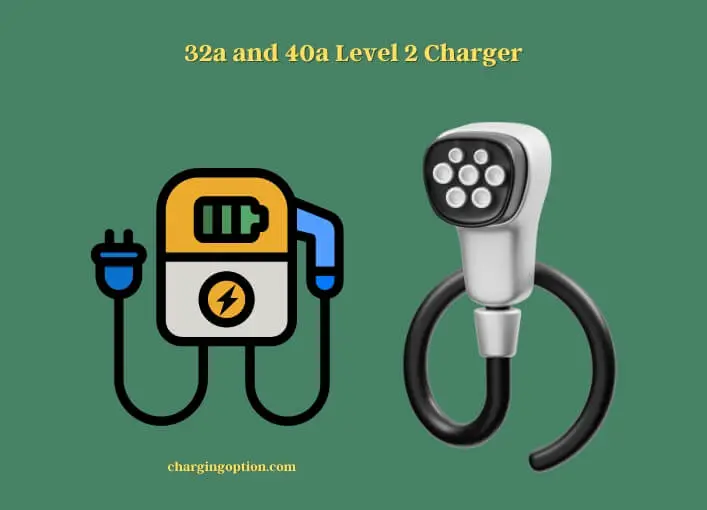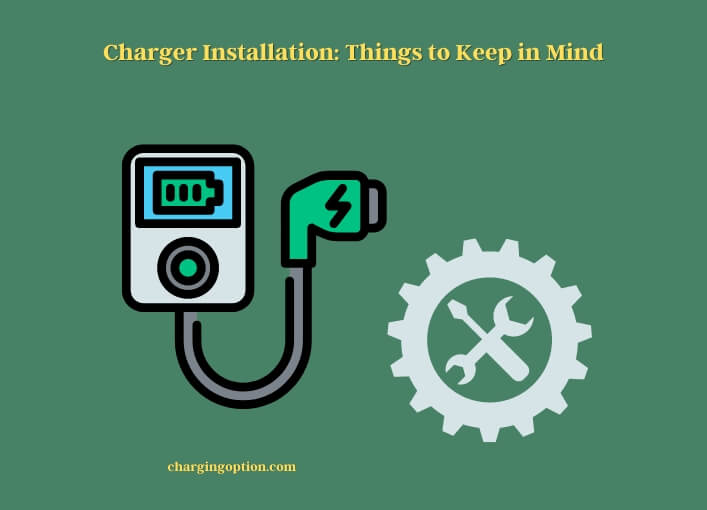The difference between a 32A and a 40A level 2 charger primarily lies in their charging speeds and power requirements. A 32A charger typically charges an electric vehicle (EV) at a rate of around 7.7 kW, while a 40A charger can offer rates up to 9.6 kW.
Level 2 EV chargers operate on 240-volt circuits, similar to a home’s dryer or oven, and provide a substantial boost in charging speed over level 1 chargers. A 32A level 2 charger, rated for a 40A circuit, is a popular choice among EV drivers. Not only is it efficient, but it’s also compatible with many electric vehicles on the market, including those that can’t accept a full 40A charge. Nonetheless, some drivers opt for the 40A EV charger to future-proof their charging infrastructure or to accommodate EVs that can accept a higher charge.

Breaker size is a vital factor to consider in the installation of these chargers. A 32A EV charger generally requires a 40A circuit breaker, while a 40A EV charger often necessitates a 50A breaker. These requirements are crucial to ensuring safety and efficiency during the charging process.
On the other hand, level 3 EV chargers are high-powered units, capable of delivering an enormous amount of power, often exceeding 60A. While this gives them the ability to charge EVs very rapidly, their installation and usage requirements often make them impractical for home use.
In the search for the best 32A EV charger, compatibility with the vehicle, charging speed, safety features, and user reviews should be considered. While both 32A and 40A chargers offer robust and reliable EV charging solutions, choosing the right one largely depends on individual power requirements, vehicle compatibility, and personal preferences.
Electric Vehicles: A Surge in Popularity
The Exponential Growth of the EV Market
The electric vehicle (EV) industry is booming, with a noticeable increase in sales worldwide. New models are continuously being launched, reflecting advancements in technology and growing consumer demand.
Role of Charging Infrastructure in EV Adoption
The availability and quality of charging infrastructure directly influence the choice to go electric. As EVs become more mainstream, charging infrastructure must keep pace.
Foundation of EV Charging
Elucidating EV Charging Levels
Charging an EV is not a one-size-fits-all process. There are three primary levels: Level 1, Level 2, and DC Fast Charging, each offering different power outputs and charging speeds.
Distinguishing Characteristics of Level 1, Level 2, and DC Fast Chargers
While Level 1 is the slowest and uses standard household power, Level 2 is faster, requiring a specialized charging station. DC Fast Charging, the quickest option, is typically found in commercial settings.
The Pivotal Role of Level 2 Chargers
Detailing the Functionality of Level 2 Chargers
Level 2 chargers provide a balance between speed and affordability. They are faster than Level 1 and less expensive than DC Fast Charging, making them suitable for home use.
Relevance of Level 2 Chargers in Home and Public Charging Infrastructure
In homes and many public charging stations, Level 2 chargers are the norm. They offer a practical solution, balancing charging speed, cost, and infrastructure needs.
Scrutinizing the 32a Level 2 Charger
Key Features of the 32a Level 2 Charger
The 32a charger, capable of delivering power up to 7.6 kW, is a common choice for many EV owners. It provides a steady charge, capable of fully charging most EVs overnight.
Positive Aspects of the 32a Level 2 Charger
32a chargers are versatile, compatible with many EV models, and are relatively easy to install in most homes. They offer adequate charging speeds for daily use.
Potential Limitations of 32a Level 2 Chargers
One potential limitation is the charging speed. For vehicles with larger battery capacity, a 32a charger might take longer to fully charge the battery.
Evaluating the 40a Level 2 Charger
Main Attributes of the 40a Level 2 Charger
A 40a Level 2 charger provides up to 9.6 kW of power, meaning it can charge your EV faster than a 32a charger.
Positive Facets of the 40a Level 2 Charger
A 40a charger can be an excellent choice for those with a high daily mileage or EVs with larger battery capacities. It’s also future-proof, ready for new EV models with higher charging capabilities.
Potential Drawbacks of 40a Level 2 Chargers
The primary drawback is the need for a higher-capacity electrical circuit, which may require a more expensive installation process, especially in older homes.
32a vs 40a: A Detailed Contrast
Charging Speed: A Numerical Comparison
While the 32a charger provides up to 7.6 kW, the 40a charger delivers up to 9.6 kW. This means the 40a charger can be up to 26% faster.
Energy Efficiency: Analyzing Consumption
Both chargers exhibit similar energy efficiency. The exact energy consumption can vary based on factors like ambient temperature and the specific EV model.
Compatibility with EV Models: A List
Most modern EVs are compatible with both 32a and 40a chargers. Still, it’s advisable to verify compatibility with the manufacturer’s guidelines.
Price Tags: A Table for Comparison
| Charger | Average Cost |
| 32a Level 2 Charger | $400 – $600 |
| 40a Level 2 Charger | $500 – $700 |
Opting for the Right Level 2 Charger
Factoring in Your EV’s Requirements
Selecting a charger should be based on your EV’s specific needs. Check the manufacturer’s recommendation for optimum charging speed and power level.
Recognizing the Role of Your Daily Driving Patterns
The ideal charger also depends on your driving habits. If your daily mileage is high, a faster charger like the 40a might be more suitable.
Evaluating the Electrical Capacity of Your Location
Before purchasing a 40a charger, ensure your home’s electrical system can handle the load. You might need to upgrade your electrical panel.
Long-term Cost Effectiveness: A Table
| Charger | Cost | 5-Year Cost Including Electricity |
| 32a Level 2 Charger | $500 | $2,500 |
| 40a Level 2 Charger | $600 | $2,400 |
Charger Installation: Things to Keep in Mind
Laying Out the Steps of Charger Installation
Charger installation involves several steps, from mounting the charging station to connecting the wiring. Always follow the manufacturer’s instructions.

Specific Considerations for 32a and 40a Charger Installations
For a 40a charger, a dedicated 50a circuit is usually needed. A 32a charger typically requires a 40a circuit.
Advice on Hiring a Professional Electrician
Given the complexities, hiring a professional electrician is advisable. They can ensure safe and effective charger installation.
Taking Care of Your Level 2 Charger
Maintenance Tips for 32a and 40a Chargers
Regular cleaning and inspection can help maintain charger performance. Always disconnect the charger before cleaning and avoid using harsh chemicals.
Signs of Wear and Tear: A Checklist
Look out for damage to the cable, plug, or charging station. Also, monitor the charger’s performance. If charging times increase or the charger gets excessively hot, it may need repairs or replacement.
Replacing and Upgrading Chargers: A Guide
Over time, you might need to replace or upgrade your charger. Be sure to follow proper disposal methods and consider upgrading to a higher capacity charger if your needs have changed.
Policies and Regulations Surrounding EV Charging
Current Policies Affecting EV Charging
Several policies, such as tax incentives and rebates, encourage EV charging infrastructure growth. These policies vary by location and can greatly affect the cost of owning and operating an EV charger.
Potential Future Regulations and Their Impact
As the EV market grows, so will regulations. Potential future changes may include building codes requiring EV charging infrastructure or updated safety standards.
Role of Government and Private Entities in Promoting EV Charging
Government and private entities play a crucial role in expanding the EV charging network. Through subsidies, partnerships, and public charging stations, they are making EV ownership more feasible and attractive.
FAQs
What Is a Lectron 240V 32 Amp Level 2 EV Charger?
A Lectron 240V 32 amp Level 2 EV charger is a specific brand of charger that can supply up to 7.6 kW of power to an electric vehicle. It’s a popular option for home charging due to its balance of speed and cost.
Can Different Types of Chargers Affect the Charging Speed of Level 2 Chargers?
Yes, different types of chargers can affect the charging speed of Level 2 chargers. The compatibility of the charger with the specific device charging methods can impact how quickly a device reaches a full charge. It’s important to use the right charger to ensure efficient charging.
What Are the Differences Between Level 2 Chargers and 240V Outlets?
When it comes to charging electric vehicles, understanding the differences between level 2 chargers and 240v outlet installations is vital. While level 2 chargers offer faster charging times and smart features, 240V outlet installations provide a convenient and cost-effective solution for EV owners. Depending on your needs, budget, and the availability of charging infrastructure, you can choose between these options for efficiently powering your electric vehicle.
Which Level 2 Charger Would Be Best for Charging My RV Battery?
When it comes to troubleshooting RV battery charging, choosing the right level 2 charger is crucial. Look for a charger that is compatible with your RV’s battery type and voltage requirements. Consider the charger’s power output and charging speed to ensure it meets your RV’s needs.
How Many Amps Does a Level 2 Charger Have?
Level 2 chargers can vary in their amperage, but the most common options are 32 amps and 40 amps. A 32 amp charger can deliver up to 7.6 kW of power, while a 40 amp charger can deliver up to 9.6 kW.
Can a 32 Amp Charger Be Used on a 40 Amp Circuit?
Yes, a 32 amp charger can be used on a 40 amp circuit. However, it won’t utilize the circuit’s full potential, as it will only draw 32 amps.
What Are the Power Requirements for a Level 2 Charger?
Level 2 chargers require a dedicated circuit of a suitable rating. A 32 amp charger typically requires a 40 amp circuit, and a 40 amp charger requires a 50 amp circuit.
What is the Effect of Level 2 Charging on Battery Life Compared to Level 1 Charging?
Level charging impact on battery life is a crucial consideration for electric vehicle owners. Level 2 charging, which provides higher voltage and amperage than Level 1, can affect battery longevity. While Level 2 charging is generally faster, it may slightly accelerate battery degradation due to increased heat generation during charging. However, modern EVs are designed to handle Level 2 charging without significant negative impacts on battery life.
Are All Level 2 Chargers the Same?
No, Level 2 chargers can vary based on their amperage and the power they can deliver. The two most common types are 32 amp and 40 amp chargers, which deliver 7.6 kW and 9.6 kW of power respectively.
Why Would I Choose a 40 Amp Charger Over a 32 Amp Charger?
A 40 amp charger delivers more power and can charge an EV faster than a 32 amp charger. If you have a high daily mileage or an EV with a larger battery capacity, a 40 amp charger might be more suitable for your needs.
What Is the Difference Between a 32a and a 40a EV Charger?
The main difference is the power they deliver. A 32a EV charger can deliver up to 7.6 kW of power, whereas a 40a EV charger can deliver up to 9.6 kW. This results in different charging times, with the 40a charger being faster.
Read more:
